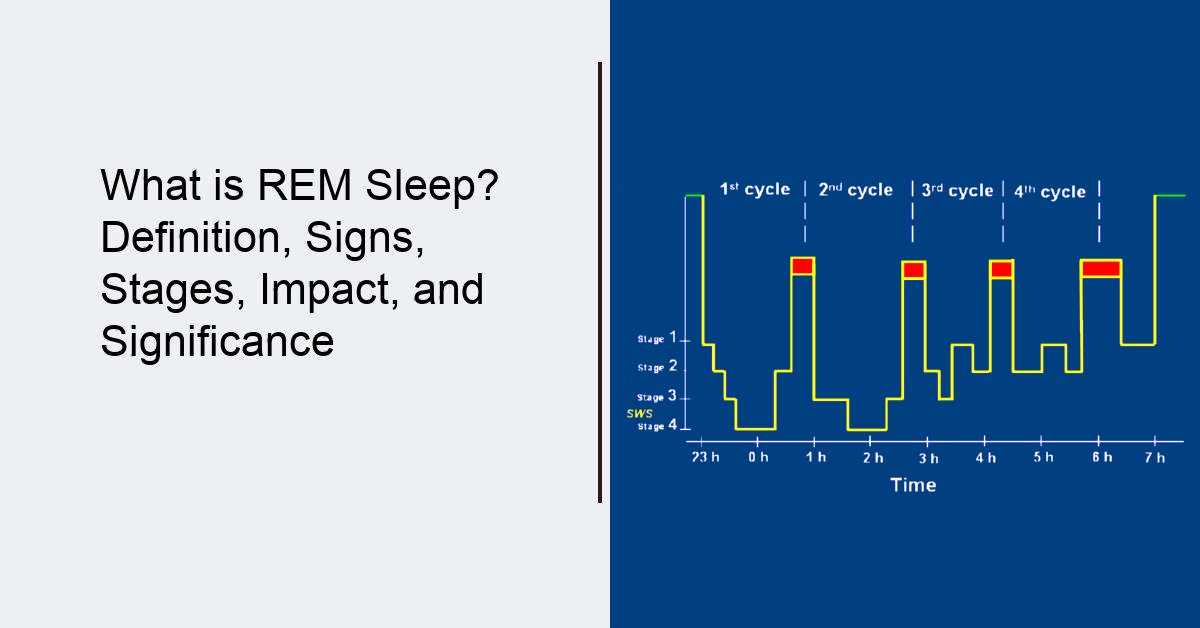REM sleep, or rapid eye movement sleep, is a stage of sleep that is characterized by increased brain activity, vivid dreaming, and eye movement. It is an essential component of the sleep cycle and plays a crucial role in maintaining physical and mental health. In this article, we will explore the signs, stages, impact, and significance of REM sleep.
What is REM Sleep?
REM sleep stands for rapid eye movement sleep, which is a stage of sleep that occurs cyclically throughout the night and is characterized by increased brain activity, rapid eye movements, muscle paralysis, and vivid dreaming. It is one of the five stages of sleep and occurs after the completion of the non-REM stages.
During REM sleep, brain activity increases, and the body becomes almost completely paralyzed, except for the diaphragm and eye muscles. This paralysis is thought to prevent people from acting out their dreams and potentially harming themselves. REM sleep is essential for memory consolidation, emotional regulation, and physical restoration, and its deprivation has been linked to several health problems, including depression, anxiety, and obesity.
Signs of REM Sleep:
REM sleep is characterized by a number of signs and symptoms. During this stage of sleep, the eyes move rapidly back and forth, hence the name “rapid eye movement.” Additionally, breathing becomes more rapid and irregular, and the heart rate and blood pressure increase. Muscles become temporarily paralyzed, which is thought to prevent individuals from acting out their dreams. Vivid dreams are common during REM sleep, and it is also the stage of sleep during which most people experience sexual arousal. REM sleep is easily identifiable by its distinctive signs. These signs include:
- Rapid eye movement: During REM sleep, the eyes move rapidly in different directions. This movement is a defining characteristic of REM sleep and is where the stage gets its name.
- Muscle paralysis: During REM sleep, the muscles in the body become relaxed and almost completely paralyzed. This paralysis is thought to prevent people from acting out their dreams and potentially harming themselves.
- Vivid dreaming: REM sleep is associated with vivid, complex dreams that often involve emotional and sometimes bizarre content.
Stages of REM Sleep:
REM sleep, or rapid eye movement sleep, is one of the five stages of sleep that occur in a cyclical pattern throughout the night. The other four stages are non-REM (NREM) sleep, which is further divided into three stages. The stages of REM sleep include:
- Stage 1: This stage is the transition from wakefulness to sleep. It is a light sleep stage, and people can be easily awakened during this stage. During stage 1, brain waves start to slow down, and the body begins to relax. This stage typically lasts for a few minutes.
- Stage 2: This stage is a deeper sleep stage. The body temperature drops, and the heart rate and breathing slow down. Brain waves continue to slow down, but occasional bursts of rapid activity, known as sleep spindles, can be seen on an electroencephalogram (EEG) recording. Stage 2 sleep usually lasts for about 20 minutes.
- Stage 3: This stage is also known as deep or slow-wave sleep. It is the deepest stage of sleep, and the body is completely relaxed. Brain waves are very slow, with a high amplitude, and are referred to as delta waves. Stage 3 sleep is important for physical restoration, as the body repairs and rejuvenates itself. This stage typically lasts for about 30 minutes.
- REM sleep: This stage occurs after the completion of the NREM stages. It is easily identifiable by its distinctive signs, including rapid eye movement, muscle paralysis, and vivid dreaming. During REM sleep, brain activity increases, and the body becomes almost completely paralyzed. This paralysis is thought to prevent people from acting out their dreams and potentially harming themselves. REM sleep typically lasts for 10 to 20 minutes in the first cycle of sleep and increases in duration as the night progresses.
The cycle of NREM and REM sleep repeats several times throughout the night, with each cycle lasting approximately 90 minutes. As the night progresses, the amount of time spent in REM sleep increases, while the amount of time spent in NREM sleep decreases. This pattern of sleep is essential for maintaining physical and mental health, as it allows the body to repair and rejuvenate itself, consolidate memories, and regulate emotions.
Impact of REM Sleep:
REM sleep plays a crucial role in several physiological and cognitive processes. Some of the impacts of REM sleep include:
- Memory consolidation: REM sleep is essential for the consolidation of memories. It is during this stage that the brain processes and consolidates information learned during the day, making it easier to retrieve later.
- Emotional regulation: REM sleep plays a role in emotional regulation, helping to reduce negative emotions such as stress, anxiety, and depression.
- Physical restoration: REM sleep is also important for physical restoration. It allows the body to repair and rejuvenate itself, helping to maintain physical health.
Significance of REM Sleep:
The significance of REM sleep lies in its role in maintaining physical and mental health. REM sleep is essential for memory consolidation, emotional regulation, and physical restoration. It also plays a role in learning and creativity, helping to facilitate problem-solving and critical thinking. REM sleep deprivation has been linked to several health problems, including depression, anxiety, and obesity.
Summary
In summary, REM sleep is a crucial stage of sleep that plays a significant role in maintaining physical and mental health. It is identifiable by its distinctive signs, including rapid eye movement, muscle paralysis, and vivid dreaming. REM sleep occurs in a cyclical pattern throughout the night and is essential for memory consolidation, emotional regulation, and physical restoration. Understanding the significance of REM sleep is essential for promoting overall health and well-being.
